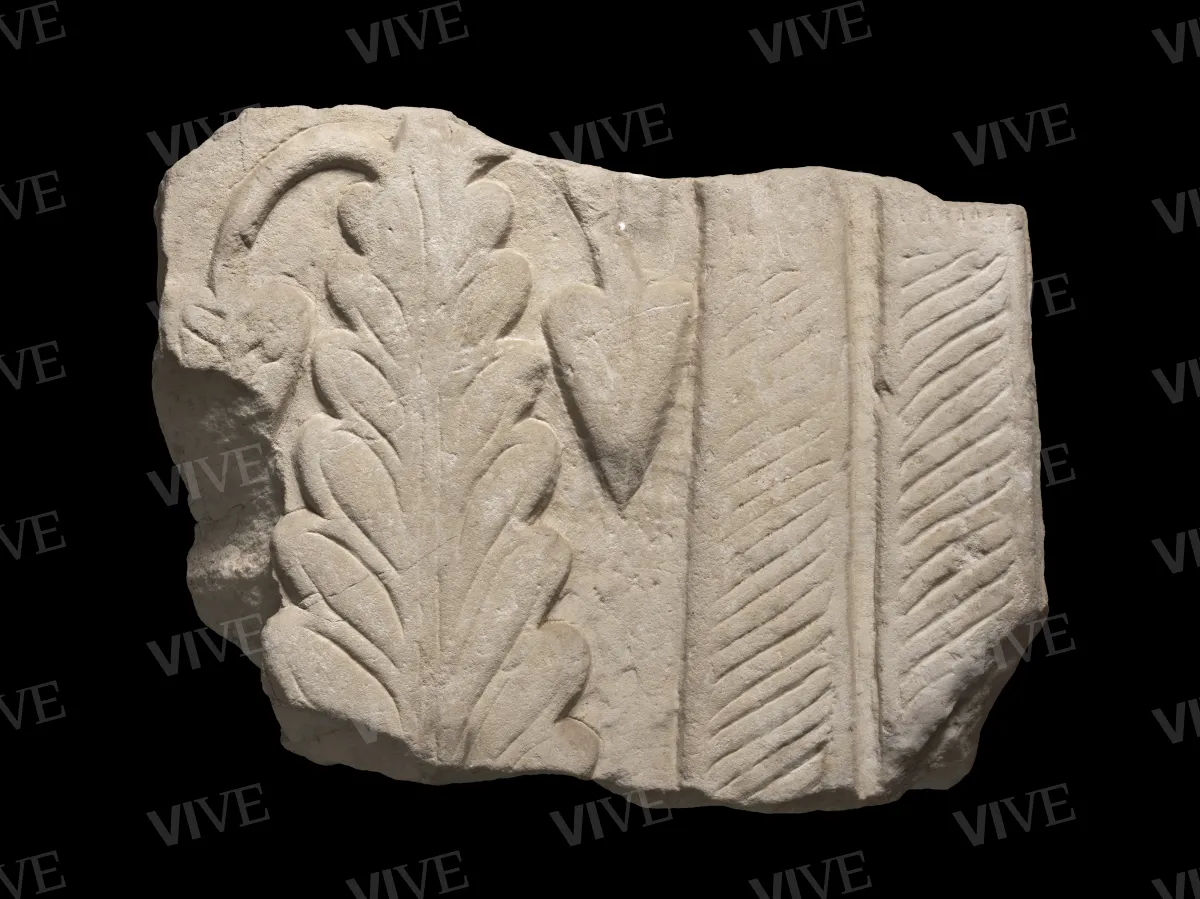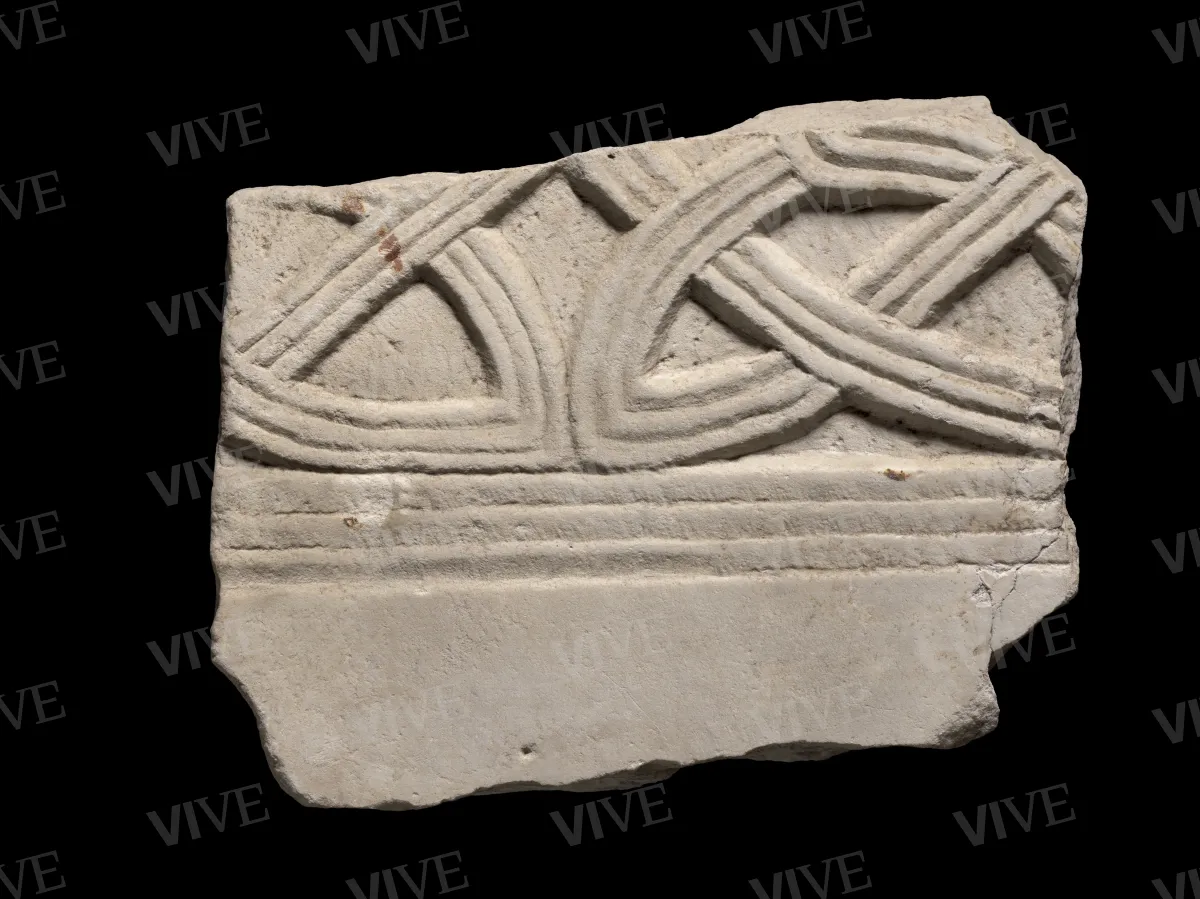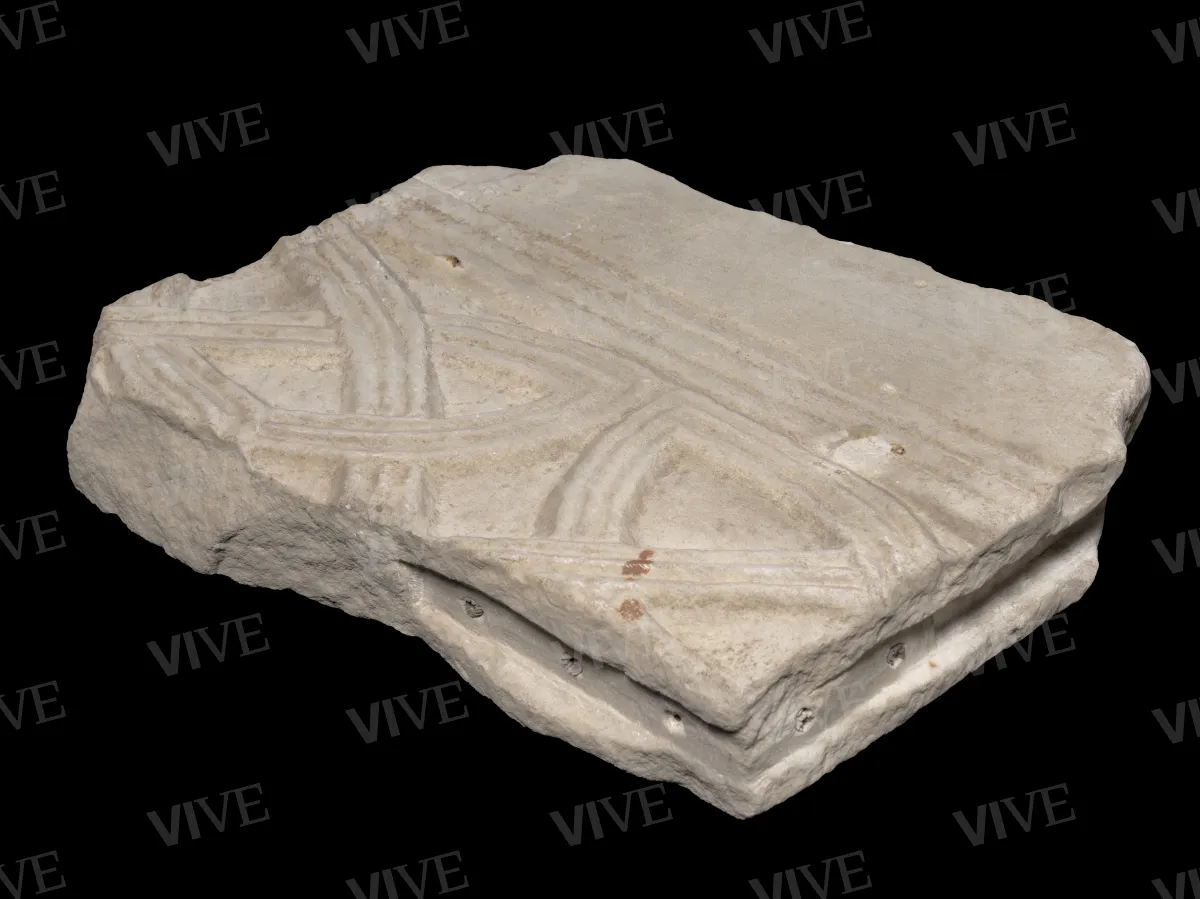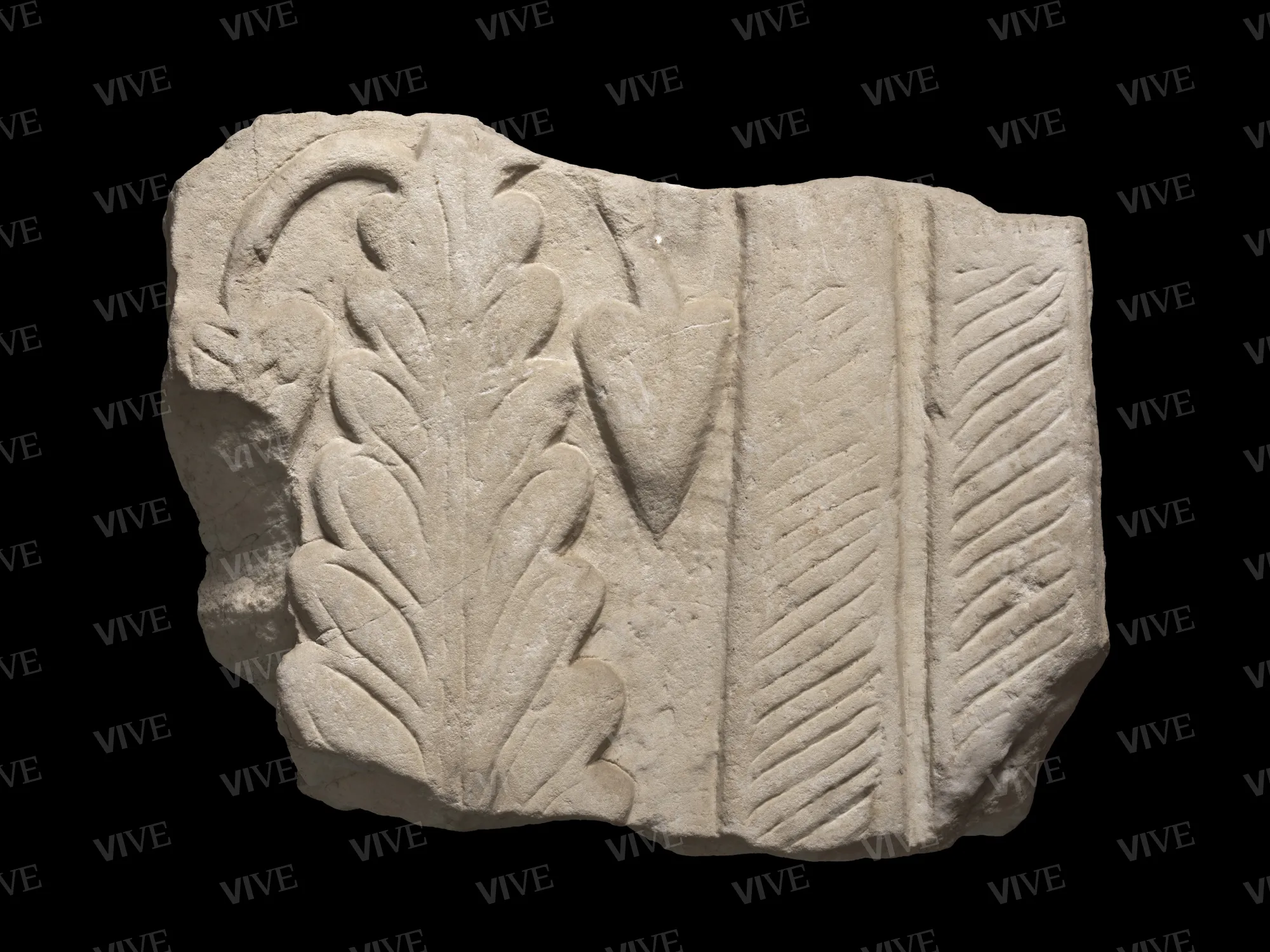Fragment of two-faced pluteus with sapling and paired columns
Roman milieu First quarter of 9th century
Fragment of a two-sided marble pluteus, decorated with a stylized sapling with profiled podded leaves and pendulous heart-shaped leaflets with a pair of Solomonic columns and two-line wicker ribbon knots with ogival loops intersected by diagonal lines, within a sawtooth frame.
Fragment of a two-sided marble pluteus, decorated with a stylized sapling with profiled podded leaves and pendulous heart-shaped leaflets with a pair of Solomonic columns and two-line wicker ribbon knots with ogival loops intersected by diagonal lines, within a sawtooth frame.
Details of work
Catalog entry
The marble fragment with two-faced sapling ornamentation and interlaced knots is, along with another artifact preserved in the Lapidarium of Palazzo Venezia (inv. 13604), part of an original liturgical decoration, most likely a presbyterial enclosure. The two qualitatively comparable fragments are characterized by the same iconographic scheme. In this fragment, the sapling, the arbor vitae of the heavenly Jerusalem, with profiled podded leaves and pendulous heart-shaped leaflets that allude to the dactyliferous palm as a symbol of resurrection and heavenly surroundings (Frugoni 1990; Spera 2000), is flanked by two Solomonic columns configuring a twin aedicule with crosses under arches (Romanini 1975; Roperti 2007; Casartelli Novelli 2019), a theme dating to the early Christian period and later renewed when it was adopted at the presbyterial enclosure of St. Peter’s Basilica in the Vatican by Gregory III (731–741) (Ballardini 2008, fig. 25) and part of the Carolingian tradition from the late eighth century—with its complex allusion to the gates of Paradise and the crucifixion, among others (Roth-Rubi 2015)—and associated with artifacts such as well heads, tomb slabs, antependia, and various pieces of ecclesiastical furnishings.
The consistency of the iconographic motifs and formal treatment makes it plausible that the two fragments of the two-sided pluteus belong to the same presbyterial enclosure context, which likely bore the iconography of the cross under an arch on one side and, on the other, a woven decorative motif common since the Carolingian period and consisting of knots of bisected wicker ribbon with ogival eyelets intersected by diagonal lines, within a sawtooth frame.
In particular, the design of the hypothetically reconstructed interlaced ornament in the form of knotted circles forming Solomon’s knots (Latini 2003, fig. 25) will have to be reconsidered on the basis of comparison with slab fragments from Santa Maria in Domnica (Melucco Vaccaro 1974, figs. 133–134; Ranucci 2003, figs. 7–8), San Giovanni a Porta Latina (Melucco Vaccaro 1974, fig. 35a), or Santa Maria in Trastevere (Bull-Simonsen Einaudi 2001, fig. 8) since the upper right half of the fragment clearly contains a knot, producing a skein of circles with knotted ogival eyelets intersected by diagonal lines.
The different distribution of the ornamentation on the two sides of the pluteus has led some to assume that the side with the interlaced decoration, visible in the lower part of the slab, leaned against a raised presbytery (Latini 2003). It is possible, however, that, as in Santa Maria in Trastevere (Bull-Simonsen 2001), the pluteus leaned against kneeling benches, used by the faithful to receive the Eucharist directly from the hands of the presbyters, in keeping with the Carolingian rite.
As for the possible dating of the two-sided pluteus, if, considering the pervasiveness of the motif, it is difficult to date the interlaced decoration to a period except for a generic first half of the ninth century, the aedicule decoration, which is similar to that of the plutei of Santa Sabina (Trinci Cecchelli 1976, in particular fig. 235; Gianandrea 2011), would suggest it could be dated to the first year of the pontificate of Eugene II (824–827) (Betti 2017; Roth-Rubi 2015). A similar sapling, a common enough emblem in the Carolingian artistic language (Lomartire 2013; Roth-Rubi 2020), datable to the first decades of the ninth century, can also be found on an antependium or pluteus slab from San Colombano in Bobbio (Destefanis 2008, fig. 2).
Our fragment displays clever carving and surface polishing and the use of a precious proconnesian marble, and can be compared to mature artifacts such as those produced in the Santa Prassede workshop on the Esquiline, commissioned by Paschal I (817–824). Moreover, the consistency of artifacts produced by workers of the Roman workshops between the two pontificates of Paschal I (817–824) and Eugene II (824–827) has been repeatedly reaffirmed (Melucco Vaccaro 1999; Melucco Vaccaro 2001; Ballardini 2008, Roth-Rubi 2015).
Valentina Brancone
Entry published on 12 February 2025
State of conservation
Fair. Roughly hewn and chiseled.
Restorations and analyses
2002–2003 (restoration directed by Maria Giulia Barberini and Maria Selene Sconci, undertaken on the occasion of the founding of the Museo di Palazzo Venezia Lapidarium).
Provenance
Unknown. Found during excavations for the Palazzetto, as part of demolition carried out in the area for the relocation of the Palazzetto di Venezia (1910–1914).
References
Melucco Vaccaro Alessandra, La Diocesi di Roma, t. III, La II regione ecclesiastica, Corpus della scultura altomedievale, VII, Spoleto 1974;
Romanini Angiola Maria, Tradizione e «mutazioni» nella cultura figurativa precarolingia, in La cultura antica nell’Occidente latino dal VII all’XI secolo, XXII Settimana di studio del CISAM, Spoleto 1975, pp. 759-789;
Trinci Cecchelli Margherita, La Diocesi di Roma, t. IV, La I regione ecclesiastica, Corpus della scultura altomedievale, VII, Spoleto 1976;
Frugoni Chiara, Alberi (in Paradiso voluptatis), in L’ambiente vegetale nell’Alto Medioevo. Settimane di studio del Centro italiano di studi sull’Alto Medioevo (30 marzo-5 aprile 1989), XXXVII, vol. II, Spoleto 1990, pp. 724-762;
Melucco Vaccaro Alessandra, Le officine marmorarie romane nei secoli VII-IX. Tradizione e apporti, in Cadei Antonio et al. (a cura di), Arte d’Occidente. Temi e metodi. Studi in onore di Angiola Maria Romanini, I, Roma 1999, pp. 299-308;
Spera Lucrezia, s.v. Traditio legis et clavium, in Bisconti Fabrizio (a cura di), Temi di iconografia paleocristiana, Città del Vaticano 2000, pp. 288-293;
Bull-Simonsen Einaudi Karin, L’arredo liturgico medievale in Santa Maria in Trastevere, in de Blaauw Sible (a cura di), Arredi di culto e disposizioni liturgiche a Roma da Costantino a Sisto IV. Atti del Colloquio internazionale (Roma, 3-4 dicembre 1999), Roma 2001, pp. 81-99;
Melucco Vaccaro Alessandra, Le botteghe dei lapicidi: dalla lettura stilistica all’analisi delle tecniche di produzione, in Roma nell’Alto Medioevo. Settimane di studio del Centro italiano di studi sull’Alto Medioevo (27 aprile-1 maggio 2000), XLVIII, vol. I, Spoleto 2001, pp. 393-420;
Latini Massimo, Sculture altomedievali inedite del Museo Nazionale del Palazzo di Venezia in Roma, in «Rivista dell’Istituto Nazionale d’Archeologia e Storia dell’Arte», 57, 2003, pp. 113-152;
Ranucci Cristina, Elementi di arredo liturgico altomedievale in Santa Maria in Dominca. Rilettura complessiva dei materiali, in Englen Alia (a cura di), Caelius I. Santa Maria in Domnica, San Tommaso in Formis e il Clivus Scauri, Roma 2003, pp. 218-227;
Roperti Antonella, Note sulla scultura, in Bonacasa Carra Rosa Maria e Vitale Emma (a cura di), La cristianizzazione in Italia tra Tardoantico ed Altomedioevo. Atti del IX Congresso Nazionale di Archeologia cristiana (Agrigento, 20-25 novembre 2004), vol. I, Palermo 2007, pp. 411-420;
Ballardini Antonella, Scultura per l’arredo liturgico nella Roma di Pasquale I: tra modelli paleocristiani e Flechtwerk, in Quintavalle Arturo Carlo (a cura di), Medioevo: arte e storia, X Convegno internazionale di studi (Pavia, 18-22 settembre 2007), Milano-Parma 2008, pp. 225-246;
Latini Massimo, in Barberini Maria Giulia (a cura di), Tracce di pietra. La collezione dei marmi di Palazzo Venezia, Roma 2008, pp. 175-194, schede 1-29;
Destefanis Eleonora, La Diocesi di Piacenza e il monastero di Bobbio, Corpus della scultura altomedievale, XVIII, Spoleto 2008;
Gianandrea Manuela, Note sul perduto arredo liturgico di Santa Sabina all’Aventino nel corso del Medioevo, in «Rivista dell’Istituto Nazionale d’Archeologia e Storia dell’Arte», s. III, 66, 2011, pp. 151-164;
Lomartire Saverio, Architettura e decorazione dell’altomedioevo in Italia Settentrionale - Una svolta sotto Carlo Magno?, in Wandel und Konstanz zwischen Bodensee und Lombardei zur Zeit Karls des Grossen. Acta Müstair, Kloster St. Johann, 3, Zürich 2013, pp. 345-372;
Roth-Rubi Katrin (in collaborazione con Sennhauser Rudolph), Die frühe Marmorskulptur aus dem Kloster St. Johann in Müstair, Ostfildern 2015;
Betti Fabio, L’arredo liturgico della Basilica di Santa Sabina al tempo di papa Eugenio II: dalla scoperta ai restauri storici (1894, 1918, 1936), in «Arte medievale», 7, 2017, pp. 31-52;
Casartelli Novelli Silvana, Decoro a "Korbboden" (fondo di canestro): una nota sul «vizio di noi occidentali, della spiegazione mimetica delle immagini, anche in presenza di disegni astratti», in «Arte medioevale», 9, 2019, pp. 9-58;
Roth-Rubi Katrin, La scultura nella Rezia, il suo legame con l’Italia e il Rinascimento carolingio, in Ammirati Serena, Ballardini Antonella, Bordi Giulia (a cura di), Grata più delle stelle. Pasquale I (817-824) e la Roma del suo tempo, vol. 2, Roma 2020, pp. 111-127;
Martorelli Rossana, Pettinelli Emanuela, La Diocesi di Albano laziale, Corpus della scultura altomedievale XXI, Spoleto 2022.
















